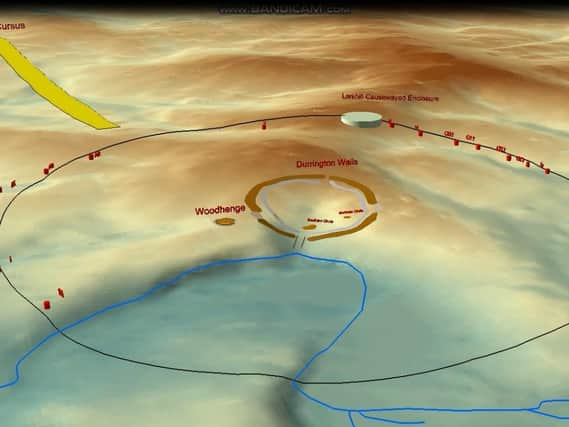Yorkshire archaeologists sensationally discover new prehistoric site near Stonehenge


A massive 2km-wide ring of prehistoric pits up to 10m across and 5m deep has been discovered around the ‘super henge’ at Durrington Walls and the famous site at Woodhenge. The structures have been carbon dated to about 2500BC.
Archaeologists believe the circle marks a boundary around the massive henge at Durrington. It is thought the features, along with an internal post line, could have guided people towards the religious sites and warned others not to cross the boundary.
Advertisement
Hide AdAdvertisement
Hide AdProfessor Vincent Gaffney from the University of Bradford said it was extraordinary such a major find had been made so close to Stonehenge.
“The area around Stonehenge is amongst the most studied archaeological landscapes on earth and it is remarkable that the application of new technology can still lead to the discovery of such a massive prehistoric structure which, currently, is significantly larger than any comparative prehistoric monument that we know of in Britain, at least.
“When these pits were first noted it was thought they might be natural features - solution hollows in the chalk. Only when the larger picture emerged, through the geophysical surveys undertaken as part of the Stonehenge Hidden Landscape Project, could we join the dots and see there was a pattern on a massive scale.”
Researchers have identified up to 20 'shafts' but estimate there may have been more than 30 originally.
Advertisement
Hide AdAdvertisement
Hide Ad“The size of the shafts and circuit surrounding Durrington Walls is without precedent within the UK. It demonstrates the significance of Durrington Walls Henge, the complexity of the monumental structures within the Stonehenge landscape, and the capacity and desire of Neolithic communities to record their cosmological belief systems in ways, and at a scale, that we had never previously anticipated.”
Dr Nick Snashall, National Trust archaeologist for the Stonehenge and Avebury World Heritage Site, said: “As the place where the builders of Stonehenge lived and feasted Durrington Walls is key to unlocking the story of the wider Stonehenge landscape, and this astonishing discovery offers us new insights into the lives and beliefs of our Neolithic ancestors.
“The Hidden Landscapes team have combined cutting-edge, archaeological fieldwork with good old-fashioned detective work to reveal this extraordinary discovery and write a whole new chapter in the story of the Stonehenge landscape.”
Coring of the shafts provided radiocarbon dates suggesting these features are Neolithic and were excavated more than 4,500 years ago, around the time that Durrington Walls was constructed. Archaeologists believe that the shafts served as a boundary to a sacred area or precinct associated with the henge. The Neolithic period, which is associated with the first farmers in Britain, is characterised by the development of ornate, and occasionally very large, rituals structures and enclosures, including the great stone circle at Stonehenge. However, no comparative prehistoric structure in the UK encloses such a large area as the circle of shafts at Durrington, and the structure is currently unique.
Advertisement
Hide AdAdvertisement
Hide AdAside from the scale of the structure, the circuit of shafts has other surprising characteristics. The boundary appears to have been deliberately laid out to include an earlier prehistoric monument within the boundary - the Larkhill Causewayed Enclosure. This site was built more than 1,500 years before the henge at Durrington. This distance between the henge and earlier enclosure, more than 800 metres, seems to guide the placement of shafts around Durrington. The evidence for how these features were laid out is extremely important as implies that the early inhabitants of Britain used a tally or counting system to track pacing across long distances. Evidence for such careful planning, at such a scale, is unexpected and emphasises how important the positioning of these features was.
Archaeologists believe the effort invested in the circuit inscribed by the pits reflects an important cosmological link between these two ritual sites, and that the large shafts were dug to record what must have been an important, sacred boundary. The presence of such massive features, and perhaps an internal post line, guided people towards the religious sites within the circle or may have warned those who were not permitted to cross the boundary marked by the shafts.
Professor Gaffney added: “The size of the shafts and circuit surrounding Durrington Walls is without precedent within the UK. It demonstrates the significance of Durrington Walls Henge, the complexity of the monumental structures within the Stonehenge landscape, and the capacity and desire of Neolithic communities to record their cosmological belief systems in ways, and at a scale, that we had never previously anticipated."